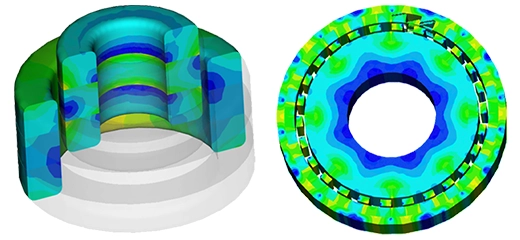MRI BASICS
Magnetic Resonance Imaging, or MRI, is a cutting-edge imaging technique that provides detailed images of organs and tissues throughout the body, all without the need for x-rays or ionizing radiation. By leveraging powerful external static magnetic fields and RF waves, MRI interacts with hydrogen atoms to generate clear and precise images. Notably, unlike X-rays and CT scans, MRI emits no ionizing radiation, ensuring patients can undergo unlimited scans in a year without health concerns.
Birdcage Coil MRI design
INTERACTION WITH METALS
While MRI imaging boasts the advantage of emitting no ionizing radiation, it faces significant limitations related to metal interactions. Firstly, the powerful static magnetic field generated by MRI machines exerts a magnetic force on ferromagnetic materials like iron or steel. This poses a risk for patients wearing jewelry or having implants containing ferromagnetic impurities, potentially leading to dangerous or life-threatening situations. Moreover, the varying RF waves induce currents in metallic parts, causing heat generation and subsequent burns. Higher frequencies and electric conductivity exacerbate this risk, emphasizing the need for careful consideration in MRI procedures.
In recent years, efforts by MRI manufacturers and implant designers have focused on overcoming the limitations posed by metal interactions. Electromagnetic simulation plays a crucial role in virtually exploring innovative solutions to address these challenges, aiming to make MRI imaging more accessible to all. Regulatory bodies like the FDA now require simulation results as a prerequisite to actual testing, highlighting the importance of this approach. EMWorks' widely-used electromagnetic packages, EMS and HFWorks, offer valuable tools for the virtual prototyping of MRI and implant designs, facilitating the development of safer and more effective solutions.
RF-Heated Metallic Stent Implant inside MRI
EMS FOR STATIC FORCE
Magnetic flux density around the MRI head obtained by EMS
HFWORKS FOR RF FIELDS
HFWorks is widely used by MRI and implant designers to analyze high-frequency aspects of MRI machines. It calculates electromagnetic fields, SAR, and temperatures throughout the system, offering essential insights for optimizing performance and safety.
Temperature and local SAR distributions around Medical Hip Implant
SUMMARY AND TAKEAWAYS
Through innovative solutions addressing metal interactions, MRI safety is significantly enhanced, providing reassurance for patients undergoing scans. By managing potential risks associated with ferromagnetic materials and RF-induced currents, the integrity and safety of MRI procedures are ensured. This commitment to safety underscores the dedication of MRI manufacturers and implant designers to advancing technology and improving patient outcomes in medical imaging.



